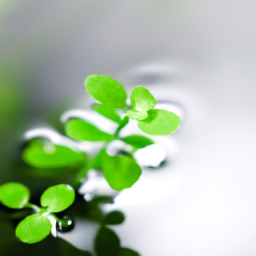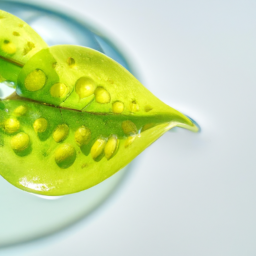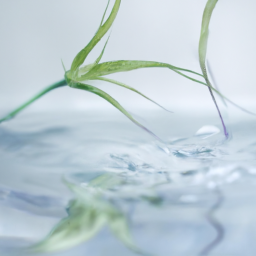
Have you ever considered growing an indoor plant in water? It may sound unconventional, but it’s actually a popular and low-maintenance way to bring some greenery into your home. Indoor plants in water can thrive and add a touch of nature to your living space without the need for soil. In this blog post, we will explore the benefits of growing indoor plants in water, the best plants to choose, and how to care for them to ensure they stay healthy and vibrant. So, if you’re looking to add some green to your home without the hassle of traditional soil-based gardening, keep reading to learn more about this unique and stylish way to bring the outdoors in.
Benefits of Growing Indoor Plants in Water
Indoor plants are a great way to bring nature into your home and create a calming and inviting atmosphere. While most people are familiar with growing plants in soil, there is a growing trend of growing indoor plants in water. This method, known as hydroponics, offers several benefits that make it a popular choice for plant enthusiasts.
Improved Air Quality
Indoor plants are known for their ability to purify the air by removing toxins and pollutants. When plants are grown in water, they are able to filter out impurities more effectively, leading to cleaner and fresher indoor air. This can have a positive impact on your health and well-being, as clean air is essential for respiratory health.
In addition, growing plants in water can help to increase humidity levels in your home, which is beneficial for both your plants and your own comfort. Dry indoor air can lead to a variety of issues, such as dry skin and respiratory problems, so having plants that release moisture into the air can help to alleviate these problems.
Overall, growing indoor plants in water can help to create a healthier and more pleasant indoor environment for you and your family.
Low Maintenance
One of the biggest advantages of growing indoor plants in water is that it requires less maintenance than traditional soil-based gardening. With hydroponics, you don’t have to worry about watering your plants as frequently, as the roots are constantly submerged in water. This can be especially beneficial for busy individuals or those who may not have a green thumb.
Additionally, growing plants in water eliminates the need for soil, which can be messy and attract pests. This means less time spent on repotting, fertilizing, and dealing with soil-related issues. Overall, hydroponic plants are easier to care for and can thrive with minimal effort on your part.
With the right setup and proper care, you can enjoy beautiful and healthy indoor plants without the hassle of traditional gardening.
Enhanced Growth and Productivity
Plants that are grown in water tend to grow faster and produce more foliage compared to their soil-grown counterparts. This is because the roots have direct access to water and nutrients, allowing them to absorb what they need more efficiently. As a result, hydroponic plants can grow larger and healthier, making them a visually appealing addition to your indoor space.
In addition, growing plants in water can also increase the yield of edible plants, such as herbs and vegetables. With the right setup and proper nutrient solution, you can create a thriving indoor garden that provides you with fresh produce year-round. This can be a rewarding and cost-effective way to enjoy homegrown fruits and vegetables.
Overall, growing indoor plants in water can lead to enhanced growth and productivity, allowing you to enjoy a lush and bountiful indoor garden.

Best Indoor Plants to Grow in Water
Indoor plants can add a touch of nature to any living space, but not everyone has a green thumb. If you’re looking for low-maintenance plants that are easy to care for, growing indoor plants in water might be the perfect solution. Not only is it a simple and cost-effective way to grow plants, but it can also be a fun and rewarding experience. Here are some of the best indoor plants to grow in water:
Pothos
Pothos, also known as devil’s ivy, is a popular indoor plant that thrives in water. It has heart-shaped leaves that come in a variety of colors, making it a beautiful addition to any room. To grow pothos in water, simply place a cutting of the plant in a glass jar filled with water. Make sure to change the water every few weeks to prevent stagnation and root rot. Pothos is a low-maintenance plant that can thrive in a variety of light conditions, making it perfect for beginners.
One of the best things about growing pothos in water is that you can easily propagate new plants from cuttings. Simply snip a stem with a few leaves and place it in water until roots start to grow. Once the roots are established, you can transfer the cutting to soil or continue to grow it in water. Pothos is a versatile plant that can adapt to different environments, making it a great choice for both experienced and novice gardeners.
When growing pothos in water, it’s important to keep an eye on the roots to ensure they don’t become waterlogged. If you notice the roots turning brown or mushy, it’s a sign that the plant is not getting enough oxygen. To prevent root rot, make sure to change the water regularly and provide adequate air circulation around the roots. With proper care, pothos can thrive in water for years, bringing beauty and greenery to your home.
Lucky Bamboo
Lucky bamboo is a popular indoor plant that is believed to bring good luck and prosperity. It is actually not a bamboo plant, but a member of the Dracaena family. Lucky bamboo can be grown in water or soil, but it thrives in a vase filled with water and pebbles. To grow lucky bamboo in water, simply place the plant in a container with water and add pebbles to support the stems. Make sure to keep the water level consistent and change it every few weeks to prevent algae growth.
Lucky bamboo is a low-maintenance plant that requires minimal care. It can thrive in low light conditions and doesn’t need frequent watering. However, it’s important to keep an eye on the water level to ensure the roots are submerged. If the water level drops too low, the plant may start to wilt and lose its vibrant green color. By providing the right amount of water and light, lucky bamboo can grow tall and healthy, adding a touch of zen to your home.
One of the unique features of lucky bamboo is its ability to grow in different shapes and arrangements. You can twist and bend the stems to create intricate designs, making it a versatile plant for home decor. Whether you prefer a simple straight stem or a complex spiral shape, lucky bamboo can be customized to suit your style. With its elegant appearance and symbolic meaning, lucky bamboo is a popular choice for indoor plant enthusiasts.
Spider Plant
Spider plants are known for their long, arching leaves and small white flowers. They are easy to grow and can thrive in a variety of conditions, making them a popular choice for indoor gardens. To grow spider plants in water, simply place a cutting of the plant in a glass jar filled with water. Make sure to submerge the roots in water and change it regularly to prevent stagnation. Spider plants prefer bright, indirect light and can tolerate dry conditions, making them a low-maintenance option for busy gardeners.
One of the unique features of spider plants is their ability to produce “baby” plants, also known as spiderettes. These small offshoots grow from the main plant and can be propagated to create new plants. To propagate spider plants, simply snip off the spiderettes and place them in water until roots start to grow. Once the roots are established, you can transfer the new plants to soil or continue to grow them in water. Spider plants are fast-growing and can quickly fill a space with lush greenery, making them a great choice for indoor plant enthusiasts.
When growing spider plants in water, it’s important to provide adequate support for the leaves to prevent them from becoming waterlogged. Make sure to choose a container that is wide enough to accommodate the plant’s roots and leaves. Spider plants are sensitive to fluoride and chlorine in tap water, so it’s best to use filtered or distilled water. By providing the right growing conditions, spider plants can thrive in water for years, bringing beauty and vitality to your home.

How to Care for Indoor Plants Growing in Water
Choosing the Right Plants
When it comes to growing indoor plants in water, not all plants are created equal. Some plants are better suited for this method of growth than others. When choosing plants to grow in water, it’s important to select ones that are known for thriving in water-based environments. Some popular choices include pothos, spider plants, lucky bamboo, and philodendron.
Before transferring your plant into water, make sure to inspect the roots for any signs of damage or rot. Healthy roots are essential for the plant to thrive in a water-based environment. If you notice any issues with the roots, trim away any damaged areas before placing the plant in water.
Setting Up the Water Environment
Once you have selected the right plants, it’s time to set up the water environment for them to grow in. Choose a container that is large enough to accommodate the plant’s roots and allow room for growth. Glass containers are popular choices for growing plants in water, as they allow you to easily monitor the root growth.
Fill the container with room temperature water, making sure to cover the roots of the plant. It’s important to use filtered or distilled water, as tap water can contain chemicals and minerals that can be harmful to the plant. Change the water every 1-2 weeks to prevent the growth of algae and bacteria.
Maintaining Your Indoor Plants
Caring for indoor plants growing in water is relatively low maintenance, but there are a few key steps to keep in mind to ensure your plants thrive. Make sure to place your plants in a location with bright, indirect sunlight. Direct sunlight can cause the water to evaporate quickly and lead to algae growth.
Monitor the water level regularly and top up as needed to ensure the roots are always submerged. If you notice any slimy or discolored roots, remove the plant from the water, rinse the roots, and replace the water. Trim away any dead or yellowing leaves to encourage new growth.
By following these steps and providing the right care, your indoor plants growing in water can thrive and add a touch of greenery to your home. Remember to enjoy the process and watch as your plants flourish in their water-based environment.
Key Takeaways of this article
Have you ever considered growing indoor plants in water instead of soil? It may sound unconventional, but water propagation is actually a popular and effective method for cultivating a variety of plants. By simply placing cuttings in a container of water and changing it regularly, you can watch your plants grow roots and thrive without the need for traditional potting mix.
One of the key benefits of growing plants in water is that it eliminates the risk of overwatering, as the roots can absorb exactly what they need. This method also allows you to easily monitor root development and adjust water levels accordingly. Plus, water propagation can be a fun and visually appealing way to display your plants, as clear containers showcase the roots growing beneath the surface. So why not give it a try and see how your indoor plants flourish in water?
FAQ Compilation:
Q1: Can indoor plants grow in water?
A1: Yes, many indoor plants can thrive in water without the need for soil. This method is known as hydroponics, where plants receive all the necessary nutrients directly from the water.
Q2: What are some indoor plants that can grow in water?
A2: Some popular indoor plants that can grow in water include pothos, lucky bamboo, peace lilies, spider plants, and philodendrons. These plants are known for their ability to adapt well to water-based environments.
Q3: How do I care for indoor plants growing in water?
A3: To care for indoor plants growing in water, make sure to change the water regularly to prevent stagnation and root rot. Also, ensure that the plants receive enough sunlight and nutrients to support healthy growth.
Q4: Can I propagate indoor plants in water?
A4: Yes, propagating indoor plants in water is a common and effective method. Simply cut a healthy stem or leaf from the parent plant and place it in a container of water. Roots will eventually grow, and you can then transfer the cutting to soil.
Q5: What are the benefits of growing indoor plants in water?
A5: Growing indoor plants in water can help improve air quality, add a touch of greenery to your space, and create a unique and visually appealing display. Additionally, water-based plants can be easier to maintain than those grown in soil.
Dr. Olivia Green is a botanist with over two decades of experience in indoor plant cultivation. She holds a Ph.D. in Plant Biology and has dedicated her career to researching plant behavior in controlled environments. Dr. Green is passionate about helping plant enthusiasts master the art of indoor gardening through her extensive knowledge and practical insights.


